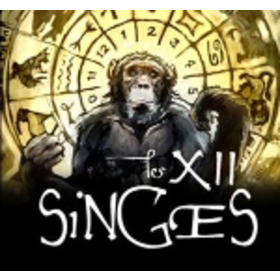Ханабі
 У гэтай калектыўнай гульні ўсё гульцы працуюць разам, каб стварыць прыгожы феерверк.
У гэтай калектыўнай гульні ўсё гульцы працуюць разам, каб стварыць прыгожы феерверк.
Але кожны гулец павінен трымаць свае карты асабовым бокам ад сябе: вы не можаце бачыць свае ўласныя карты!
Такім чынам, вы павінны даць сваім партнёрам разумны савет і запомніць ўсю сабраную інфармацыю.
Колькасць гульцоў: 2 - 5
Працягласць гульні: 10 mn
Складанасць: 2 / 5
Згуляйце ў Ханабі і 1184 іншых гульняў онлайн.
Без запампоўкі, проста з вашага браўзэра.
З вашымі сябрамі і тысячамі гульцоў з усяго свету.
Гуляйце бясплатна.

Згуляйце ў Ханабі і 1184 іншых гульняў онлайн.
Без запампоўкі, проста з вашага браўзэра.
З вашымі сябрамі і тысячамі гульцоў з усяго свету.
Гуляйце бясплатна.

Кароткія правілы
Introduction
Hanabi is a cooperative game. Your goal, as a team, is to build a fabulous fireworks show. You do this by playing the cards in the correct order. However, you cannot see your own cards; you can only see the cards of your team mates.
Final Score Ratings
| Points | Overall impression |
|---|---|
| 5 or less | horrible, booed by the crowd... |
| 6-10 | mediocre, just a spattering of applause. |
| 11-15 | honourable, but will not be remembered for very long... |
| 16-20 | excellent, crowd pleasing. |
| 21-24 | amazing, will be remembered for a very long time! |
| 25 | legendary, everyone left speechless, stars in their eyes |
Card distribution
In a game of Hanabi on NORMAL DIFFICULTY, the deck contains 50 cards. Each has exactly one colour: either Red, Yellow, Green, Blue, or White.
There are 10 cards in each colour:
- three 1s
- two 2s
- two 3s
- two 4s
- one 5
Multicolour cards
There are three variants that add a 6th colour: the multicolour.
- TRICKY DIFFICULTY adds 10 multicolour cards to the normal game. These cards get marked by a separate multicolour clue.
- HARD DIFFICULTY adds 5 multicolour cards to the normal game: one of each number. These cards get marked by a separate multicolour clue.
- VERY DIFFICULT DIFFICULTY adds 10 multicolour cards to the normal game. These cards get marked by ANY colour clue.
Gameplay
You each take turns. During a turn, a player may take one (1) of three actions. After your action, the turn ends and it is the next player's turn.
The game can end in several ways:
- All cards have been drawn from the deck. After this happens, everybody gets 1 more turn. The game ends with the score at the last turn.
- Your team played all possible cards. In this case, the game ends immediately and you receive the maximum possible score.
- Your team made three mistakes that caused misfires. In this case, you lose the game and get negative ten (-10) points.
- Your team 'abandons' the game. Although discouraged, you receive zero (0) points.
Turn
During your turn, you have one (1) action. You can choose to do one of the following:
- Give a colour or number clue to a teammate: This costs one clue-token (-1). You cannot give a clue if there are zero (0) clue-tokens left. When you give a clue, you must indicate ALL cards of a certain colour, or ALL cards of a certain number.
- Play a card: When a card is played, it is evaluated. If the card fits in one of sequences, it is placed in the appropriate colour stack on the table. If it does not, it is placed in the discard pile and the team gets a misfire-token.
- Discard a card: When you discard, the card is placed in the discard pile and you get a clue-token (+1). Note: cards on the discard pile are out of the game and can never return.
When you remove a card from your hand, by either playing or discarding, at the end of your turn, you draw a new card. Your newest card is always placed on the left.
Lingo
When you play with others, certain words are used to describe certain objects or situations. Here is a short list.
- MARKED: A card that is highlighted by a clue.
- UNMARKED: A card that is not clued.
- CHOP: The oldest, unmarked card. The right-most card that you have no information on and will chop from your hand.
- DRAW: The newest, unmarked card. The left-most card that you have no information on and was freshly drawn to the left side.
- TO BOMB: A play that causes the third misfire-token. Sometimes called EXPLOSION
- UNIQUE: A card that has no copy (left) in the deck.
- DOUBLE DISCARD: Discarding the (usually CHOP) card when it can be Unique (or the last copy of the card in the discard pile).
- DOUBLE SAVE: To mark a card that is useless, because the copy of the card is already played, or marked.
- STRATEGY: A set of rules / guidelines / conventions on how to interpret actions by players (including spending of clue-tokens).
ELO rating
If you are playing with ELO rating on, your ELO may be changed at the end of the game.
Here is how it works:
- Every player on the team is temporarily considered as having the average ELO rating of the team.
- The system will generate a bot associated with the score your team has achieved (let’s call it Hanabot). Hanabot’s ELO rating depends on the variant you are playing (50 cards, 60 cards, 60 cards multicolor), the number of players on the team and, most importantly, your team's score. All Hanabot’s ELO ratings have been set by an experienced player, they are not random or simply proportional to the score/number of players.
- Your team (actually your team's average ELO) will now compete against Hanabot. The system will calculate your team’s ELO gain/loss as though your team had tied with Hanabot.
If your score is below 18 (50-card game) or below 21 (60-card game), Hanabot's ELO is always 1000.
You can find all bots' ELO ratings here: http://forum.boardgamearena.com/viewtopic.php?f=3&t=4814
The 55-card variant (50 cards + 1 of each value in the sixth color) cannot be played with ELO rating on. This is because this variant is highly dependent on draw and a team’s score may not always reflect the players’ skills.
If you achieve the perfect score and this should cost you ELO points, you will be considered as having beaten the bot associated with the score, so that you lose no ELO points.
To be confirmed: I think the ELO-system has had an overhaul.
About "cheating"
In the "real life Hanabi", you can talk. That's why we chose to let the chat open for the online version.
As a consequence, it is very easy to cheat at Hanabi. However, as you can imagine, cheating is very stupid and has no interest... except for ELO boosting. This is why there is no international ranking for this game (ie: best player, second best player) and no trophies associated to it.
CONVENTIONS
If people just play in a very basic way, meaning that they wait until they have received the colour and number to play each card, it is generally difficult to achieve a high score. Common sense, observation and combination of given information allow to visualize which card(s) should be played according to a single clue (thus saving precious clue-tokens and speeding up the game in order to reach a better score). However, many players have elaborated conventions in order to codify the sequence of actions and thus simplify the thinking process.
In the following section, colours are indicated by their first letter: R - Red, Y - Yellow, G - Green, B - Blue, W - White. For example, 2Y means the card with number 2 and colour yellow.
Most standard convention
In 4 words : Play left, discard right.
- When a clue designates several cards, it is generally the card furthest to the left that must be played.
Indeed, the new cards arriving from the left, a playable card already in hand would have been indicated earlier whereas it is more likely that one wants to play the freshly drawn. For example, if a player's hand is (1R, 4Y, 5B, 2Y, 2G), it is necessary and enough to give the clue 2 to make him play his 2Y.
In complicated situations where the card to be indicated is neither the leftmost of its color nor the leftmost of its number, two players must complement each other by giving one of the elements each, although this rarely happens. For example, if a player's hand is (1R, 4Y, 5B, 2G, 2Y), it is necessary to give him both the clue Yellow and the clue 2 to make him play his 2Y.
- When a player, having no clue to give nor a card to play, is about to discard, he must discard his card furthest to the right among those without a clue. (the chop).
Indeed, the new cards arrive from the left, the cards on the right are older, and therefore less likely to be used since the other players have had more time to say that they should be played if necessary.
This allows other players to anticipate which cards are about to be discarded and therefore protect them if necessary. So for example, when a 5 (card present in a single copy and therefore particularly valuable) arrives in a player's discard position, the others know that it risks being discarded and therefore give the clue 5 to be preserved ( saving clue ). It should be understood from the position of the card that it is thus to be preserved and not to be played, paying attention to the cards already discarded (last copy).
In complicated situations where all of our cards have a clue and therefore theoretically no card should be discarded (since cards with clue should not be discarded) and where it is impossible to play, it is preferable to give a clue, even if it is not very relevant.
Obviously, if a player has a card that he is sure he will never be able to play (for example a card on which he has a blue hint when the blue pile has already been completed), such card must be discarded in priority.
Advanced conventions
The 3 most classical advanced conventions are: finesse, bluff et reverse.
Finesse
- An example is more telling than a long speech: suppose it is player 1's turn and no card has yet been played, nor any clue given:
1) ? ? ? ?
2) 1B 5Y 3B 1W
3) 5R 2R 2B 2G
4) 4G 1Y 1R 3Y
If player 1 gives the blue clue to player 3, it clearly indicates his 2B, while the expected card is a 1B. This means that the card which fills the hole is somewhere upstream, in this case in the hand of player 2. The latter, seeing that indeed the 1B is missing, understands that it is a question of a "finesse" and plays his 1B according to the convention "play left, discard right".
If the 1B had been in any other position in Player 2's hand, he would have needed a prior clue to know which one. Thus he would have played the card furthest to the left among his corresponding marked cards (in this case a 1 card or a blue card if the 1B and the 5Y had been reversed).
Player 3 then only has to play his 2B: two cards have been played thanks to a single clue.
- In situations like the following :
1) ? ? ? ?
2) 1B 5Y 3B 3W
3) 4G 1Y 1R 3Y
4) 5R 2R 2B 2G
where player 1 gives a clue blue to player 4, this can point to either player 2 and 3. To find out which one is designated, each looks at the other's cards. In this case, player 2 sees that finesse cannot be addressed to player 3 since he has a 4G card on the far left and not a 1B. Player 2 therefore plays his own card.
Bluff
Bluff looks like a finesse , except that the player who plays his card is in a way "trapped": he does not play the card he expects from ' 'finesse'.
An example speaks louder than a long speech: suppose it's player 1's turn and no card has yet been played, nor any clue given:
1) ? ? ? ?
2) 1W 5Y 3B 3W
3) 5R 2R 2B 2G
4) 4G 1Y 1R 3Y
If player 1 gives the blue clue to player 3, it clearly indicates his 2B, while the expected card is a 1B. As before, player 2 then assumes that his leftmost card is a 1B. So he plays it. Surprise, it's a 1W! Player 3 then understands that it is a bluff and DOES NOT PLAY his blue card. However, he knows that it is a 2, and keeps it for later, when he can play it.
Unlike "finesse", to avoid any ambiguity, it is better to "bluff" only on the person who follows us immediately in the turn order.
Reverse
Reverse looks like finesse , except that the player given the clue is located before the one with the card that fills the gap.
This convention is riskier because it is sometimes possible that the player to whom the hint is given does not realize that it is a reverse and plays his card.
An example speaks louder than a long speech: suppose it's player 1's turn and no card has yet been played, nor any clue given:
1) ? ? ? ?
2) 5R 2R 2B 2G
3) 1B 5Y 3B 3W
4) 4G 1Y 1R 3Y
If player 1 gives the blue clue to player 2, it clearly tells him his 2B, while the expected card is a 1B. He might think that it is indeed a 1B, but he sees a 1B in question in Player 3's hand and therefore plays something else (for example, he gives the clue to Player 4). Player 3, as before, seeing that the reverse cannot be addressed to player 4, plays his 1B. In the next turn, player 2 can play his 2B.
Off discard
It happens that in his turn a player no longer has a clue token and that a card must absolutely be played, it is then possible for him to discard another card than his card furthest to the right. This move tells the next player to play the card in the same position as the one that was discarded.
Example: it's player 1's turn, there are no more clue tokens, a 1B has already been played and a 2B card has already been discarded (in bold the clues known by the players):
1) a? b? c? d? e?
2) 4Y 5R 2R 2B 2G
3) 2G 1B 5Y 3B 3W
Player 1 discards card d? instead of the e? card. This indicates to the player that he must play his card in the same position (therefore 2B), which avoids losing it and thus condemning the blue pile.
This movement is risky because the discarded card can be important or even blocking for the rest of the game. This movement should therefore only be used if there is no other solution. It is up to the other players to make sure, before leaving a player without a clue token, that the card he could discard to give this clue is not essential for the rest of the game.


